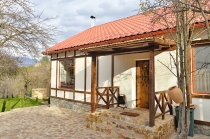
Marriott Tsaghkadzor
The hotel complex "Marriott Tsaghkadzor" offers a comfortable stay in the fresh air of Tsaghkadzor,...
Golden Palace Resort
"Golden Palace Resort-Spa" is the only officially recognized 5-star hotel in Tsakhkadzor, in...
Elegant
Elegant" hotel has stylish rooms where the guests can enjoy picturesque view of mountains and...
Villa Jrhogher
"Villa Jrhogher" is situated in the heart of Dilijan’s forests and is a perfect choice for a small group of friends, colleagues or family members to host up to 10 guests. Free private parking...Uruguay
.jpg&width=410&height=245)
| Capital | Montevideo |
| Area | 176 220 km² |
| Population | 3 372 000 people |
| Official language | Spanish |
| Currency | Uruguayan peso |
| Climate | In January - from +22°C to +24°C In July - from +10°C to +12°C |
| Recommended type of holiday | The most famous resort is Punta del Este |
About country
Laid-back and off the beaten track, tiny Uruguay welcomes visitors with miles of pristine beaches, vast open skies and one of Latin America's most cosmopolitan capital cities. Thanks to its high standard of living and the relaxed hospitality of its people, it's a delightful place to travel, yet still draws fewer tourists than neighbouring Brazil and Argentina.
Three destinations jump to the top of most traveller's itineraries: culturally vibrant Montevideo, with its lively arts scene, breezy beachfront promenade and the world's longest carnival celebration; picturesque Colonia, sporting cobblestoned streets, leafy plazas and 18th-century Portuguese colonial architecture; and trendy Punta del Este, luring jetsetters with its beaches, fine restaurants and frenetic nightlife. Visitors with more time should explore the dunes, lagoons and surf breaks of Uruguay's long Atlantic coastline, soak in the hot springs near Salto, or spend the night at a tourist estancia amidst the wide-open grandeur of gaucho country.



Sightseeing
Trek over sand dunes to see the lighthouse and abundant marine life at Cabo Polonio on the Atlantic coast.
Join the frenzy of dancing and drumming in the streets every February during Montevideo's exuberant Afro-Uruguayan Carnival
Observe the rich array of bird life at one of eastern Uruguay's coastal lagoons, including Laguna de Rocha near La Paloma, Laguna de Castillos near Barra de Valizas, and Laguna Negra near Punta del Diablo.Visit Carlos Paéz Vilaró's extravagantly whimsical art studio, Casapueblo, a nine-story whitewashed masterpiece cascading down the cliffs of Punta Ballena, near Punta del Este.
Sample Uruguay's fine dairy products in the 19th-century Swiss settlement of Colonia Suiza (The Swiss Colony), west of the capital.



Traditions
Uruguay has an impressive legacy of artistic and literary traditions, especially for its small size. The contribution of its alternating conquerors and diverse immigrants has resulted in native traditions that integrate this diversity. Uruguay has centuries old remains, fortresses of the colonial era. Its cities have a rich architectural heritage and an impressive number of writers, artists, and musicians.
The Uruguayan people revel in the art of theater as well as many musical and dance traditions. A lot of these have roots in Europe, but have evolved with their own twists of local color whether they involve plays, concerts, exhibitions, or festivals.
The tango has an entire sub-culture centered on movement, music, and lyrics. Tango is love, hate, and passion. Tango transforms one’s existential problems into pure energy and joy. And in Uruguay, people love to Tango and they Tango well!
Inland, we find the culture of the gaucho, the cowboys of South America. To this day, gauchos wear the same traditional dress as generations ago. Complete with it’s own music and dance; gaucho is about pride and dignity, individual integrity, and national identity.
As far as general arts and crafts, Uruguayans are excellent in creating the most beautiful handcrafted leather goods. Homegrown leather is transformed into belts, boots, hats, and purses. Uruguayans are also renowned for their handmade woolen items, especially woolen sweaters. There is also a niche of ceramic crafts that reflect local color.



Cuisine
The majority of Uruguayan restaurants are parrilladas (grill-rooms). Italian food also appears on many menus, and seafood eateries abound along the Atlantic coast. Quality of both meat and seafood is generally excellent. Table service is usual in restaurants. Cafés or bars have either table and/or counter service. There are no set licensing hours.
Specialities:
• Bife de chorizo (rump steak), asado de tira (short ribs) and other barbecued meats.
• Chivito (steak sandwich with accompaniments including cheese, lettuce, tomato, bacon, ham, olives and pickles).
• Morcilla dulce (sweet black sausage made from blood, orange peel and walnuts) and morcilla salada (salty sausage).
• Dulce de leche (milk sweets).
• Chajá (ball-shaped sponge cake filled with cream and jam).





